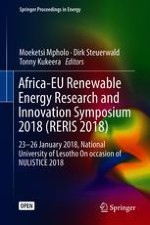2.1 Introduction
2.2 Techno-economics and Job Creation
2.2.1 Techno-economics of Mini-grids in Sub-Saharan Africa
2.2.2 Renewable Energy Employment Effects
2.3 Methodological Approach
Scenario | Abbreviation |
|---|---|
Diesel only | Base |
Solar diesel | SD |
Solar + diesel + battery | SDB |
Solar + wind + diesel | SWD |
Solar + wind + diesel + battery | SWDB |
Solar + wind + battery | SWB |
Solar + battery | SB |
Wind + battery | WB |
Wind + diesel | WD |
Wind + diesel + battery | WDB |
